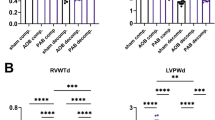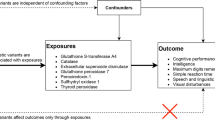Abstract
The detection of hypoxia by the carotid bodies elicits a ventilatory response of utmost importance for tolerance to high altitude. Germline mutations in three genes encoding subunit B, C and D of succinate dehydrogenase (SDHB, SDHC and SDHD) have been associated with paragangliomas of the carotid body. We hypothesized that SDH dysfunction within the carotid body could result in low chemoresponsiveness and intolerance to high altitude. The frequency of polymorphisms of SDHs, hypoxia-inducible factor type 1 (HIF1α) and angiotensin converting enzyme (ACE) genes was compared between 40 subjects with intolerance to high altitude and a low hypoxic ventilatory response at exercise (HVRe ≤ 0.5 ml min−1 kg−1; HVR− group) and 41 subjects without intolerance to high altitude and a high HVRe (≥0.80 ml min−1 kg−1; HVR+). We found no significant association between low or high HVRe and (1) the allele frequencies for nine single nucleotide polymorphisms (SNPs) in the SDHD and SDHB genes, (2) the ACE insertion/deletion polymorphism and (3) four SNPs in the HIF1α gene. However, a marginal significant association was found between the synonymous polymorphism c.18A>C of the SDHB gene and chemoresponsiveness: 8/40 (20%) in the HVR− group and 3/41 (7%) in the HVR+ group (p = 0.12). A principal component analysis showed that no subject carrying the 18C allele had both high ventilatory and cardiac response to hypoxia. In conclusion, no clear association was found between gene variants involved in oxygen sensing and chemoresponsiveness, although some mutations in the SDHB and SDHD genes deserve further investigations in a larger population.



Similar content being viewed by others
References
Aldashev AA, Sarybaev AS, Sydykov AS, Kalmyrzaev BB, Kim EV, Mamanova LB, Maripov R, Kojonazarov BK, Mirrakhimov MM, Wilkins MR, Morrell NW (2002) Characterization of high-altitude pulmonary hypertension in the Kyrgyz: association with angiotensin-converting enzyme genotype. Am J Respir Crit Care Med 166:1396–1402
Amar L, Bertherat J, Baudin E, Ajzenberg C, Bressac-de Paillerets B, Chabre O, Chamontin B, Delemer B, Giraud S, Murat A, Niccoli-Sire P, Richard S, Rohmer V, Sadoul JL, Strompf L, Schlumberger M, Bertagna X, Plouin PF, Jeunemaitre X, Gimenez-Roqueplo AP (2005) Genetic testing in pheochromocytoma or functional paraganglioma. J Clin Oncol 23:8812–8818
Appenzeller O, Minko T, Qualls C, Pozharov V, Gamboa J, Gamboa A, Wang Y (2006) Gene expression, autonomic function and chronic hypoxia:lessons from the Andes. Clin Auton Res 16:217–222
Astrom K, Cohen JE, Willett-Brozick JE, Aston CE, Baysal BE (2003) Altitude is a phenotypic modifier in hereditary paraganglioma type 1: evidence for an oxygen-sensing defect. Hum Genet 113:228–237
Basnyat B, Murdoch DR (2003) High-altitude illness. Lancet 361:1967–1974
Baysal B (2006) A phenotypic perspective on mammalian oxygen sensor candidates. Ann N Y Acad Sci 1073:221–233
Bigham AW, Kiyamu M, León-Velarde F, Parra EJ, Rivera-Ch M, Shriver MD, Brutsaert TD (2008) Angiotensin-converting enzyme genotype and arterial oxygen saturation at high altitude in Peruvian Quechua. High Alt Med Biol 9:167–178
Brugniaux JV, Schmitt L, Robach P, Jeanvoine H, Zimmermann H, Nicolet G, Duvallet A, Fouillot J-P, Richalet J-P (2006) Living high-training low: tolerance and acclimatization in elite endurance athletes. Eur J Appl Physiol 96:66–77
Burtscher M, Flatz M, Faulhaber M (2004) Prediction of susceptibility to acute mountain sickness by SaO2 values during short-term exposure to hypoxia. High Alt Med Biol 5:335–340
Dehnert C, Weymann J, Montgomery HE, Woods D, Maggiorini M, Scherrer U, Gibbs JS, Bärtsch P (2002) No association between high-altitude tolerance and the ACE I/D gene polymorphism. Med Sci Sports Exerc 34:1928–1933
Droma Y, Hanaoka M, Ota M, Katsuyama Y, Koizumi T, Fujimoto K, Kobayashi T, Kubo K (2002) Positive association of the endothelial nitric oxide synthase gene polymorphisms with high-altitude pulmonary edema. Circulation 106:826–830
Gao W, Gao Y, Zhang G, Song L, Sun B, Shi J (2005) Hypoxia-induced expression of HIF-1alpha and its target genes in umbilical venous endothelial cells of Tibetans and immigrant Han. Comp Biochem Physiol C Toxicol Pharmaco 141:93–100
Gimenez-Roqueplo AP, Burnichon N, Amar L, Favier J, Jeunemaitre X, Plouin PF (2008) Recent advances in the genetics of phaeochromocytoma and functional paraganglioma. Clin Exp Pharmacol Physiol 35:376–379
Hackett PH, Roach RC (2004) High altitude cerebral edema. High Alt Med Biol 5:136–146
Hanaoka M, Droma Y, Hotta J, Matsuzawa Y, Kobayashi T, Kubo K, Ota M (2003) Polymorphisms of the tyrosine hydroxylase gene in subjects susceptible to high-altitude pulmonary edema. Chest 123:54–58
Hohenhaus E, Paul A, McCullough RE, Kucherer H, Bartsch P (1995) Ventilatory and pulmonary vascular response to hypoxia and susceptibility to high altitude pulmonary oedema. Eur Respir J 8:1825–1833
Hotta J, Hanaoka M, Droma Y, Katsuyama Y, Ota M, Kobayashi T (2004) Polymorphisms of renin-angiotensin system genes with high-altitude pulmonary edema in Japanese subjects. Chest 126:825–830
Huang J, Lemire BD (2009) Mutations in the C. elegans succinate dehydrogenase iron–sulfur subunit promote superoxide generation and premature aging. J Mol Biol 3:559–569
Jedlickova K, Stockton DW, Chen H, Stray-Gundersen J, Witkowski S, Ri-Li G, Jelinek J, Levine BD, Prchal JT (2003) Search for genetic determinants of individual variability of the erythropoietin response to high altitude. Blood Cells Mol Dis 31:175–182
Koehle MS, Wang P, Guenette JA, Rupert JL (2006) No association between variants in the ACE and angiotensin II receptor 1 genes and acute mountain sickness in Nepalese pilgrims to the Janai Purnima Festival at 4380 m. High Alt Med Biol 7:281–289
León-Velarde F, Mejía O (2008) Gene expression in chronic high altitude diseases. High Alt Med Biol 9:130–139
Mejía OM, Prchal J, León-Velarde F, Hurtado A, Stockton DW (2005) Genetic association analysis of chronic mountain sickness in an Andean high-altitude population. Heamatologica 90:13–19
Mortimer H, Patel S, Peacock AJ (2004) The genetic basis of high-altitude pulmonary oedema. Pharmacol Ther 101:183–192
Richalet JP, Kéromès A, Dersch B, Corizzi F, Mehdioui H, Pophillat B, Chardonnet H, Tassery F, Herry JP, Rathat C, Chaduteau C, Darnaud B (1988) Caractéristiques physiologiques des alpinistes de haute altitude. Sci Sport 3:89–108
Richalet JP (1995) High-altitude pulmonary oedema. Still a place for controversy? Thorax 50:923–929
Richalet JP, Herry JP (2006) Médecine de l’alpinisme et des sports de montagne, 4th edn. Masson, Paris
Rivera-Ch M, Huicho L, Bouchet P, Richalet JP, León-Velarde F (2008) Effect of acetazolamide on ventilatory response in subjects with chronic mountain sickness. Respir Physiol Neurobiol 162:184–189
Rodríguez-Cuevas S, López-Garza J, Labastida-Almendaro S (1998) Carotid body tumors in inhabitants of altitudes higher than 2000 meters above sea level. Head Neck 20:374–378
Rupert JL, Koehle MS (2006) Evidence for a genetic basis for altitude-related illness. High Alt Med Biol 7:150–167
Saxena S, Kumar R, Madan T, Gupta V, Muralidhar K, Sarma PU (2005) Association of polymorphisms in pulmonary surfactant protein A1 and A2 genes with high-altitude pulmonary edema. Chest 128:1611–1619
Suzuki K, Kizaki T, Hitomi Y, Nukita M, Kimoto K, Miyazawa N, Kobayashi K, Ohnuki Y, Ohno H (2003) Genetic variation in hypoxia-inducible factor 1alpha and its possible association with high altitude adaptation in Sherpas. Med Hypotheses 61:385–389
The Lake Louise Consensus on The Definition and Quantification of Altitude Illness (1992) In: Sutton JR, Coates G, Houston CS (eds) Hypoxia and mountain medicine. Queen City Printers Inc., Burlington, pp 327–330
Thompson J, Raitt J, Hutchings L, Drenos F, Bjargo E, Loset A, Grocott M, Montgomery H, Caudwell Xtreme Everest Research Group (2007) Angiotensin-converting enzyme genotype and successful ascent to extreme high altitude. High Alt Med Biol 8:278–285
Williams AG, Rayson MP, Jubb M, World M, Woods DR, Hayward M, Martin J, Humphries SE, Montgomery HE (2000) The ACE gene and muscle performance. Nature 403:614
Zhou F, Wang F, Li F, Yuan J, Zeng H, Wei Q, Tanguay RM, Wu T (2005) Association of hsp70-2 and hsp-hom gene polymorphisms with risk of acute high-altitude illness in a Chinese population. Cell Stress Chaperones 10:349–356
Acknowledgments
We thank the nurses of the Centre d’Investigations Cliniques and the technicians of the molecular genetic laboratory at the Hôpital Européen Georges Pompidou for their technical support. This study was supported by a grant delivered by the Société Française d’Hypertension Artérielle and promoted by the Société Française de Cardiologie.
Author information
Authors and Affiliations
Corresponding author
Rights and permissions
About this article
Cite this article
Richalet, JP., Gimenez-Roqueplo, AP., Peyrard, S. et al. A role for succinate dehydrogenase genes in low chemoresponsiveness to hypoxia?. Clin Auton Res 19, 335–342 (2009). https://doi.org/10.1007/s10286-009-0028-z
Received:
Accepted:
Published:
Issue Date:
DOI: https://doi.org/10.1007/s10286-009-0028-z




